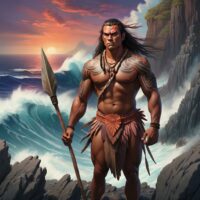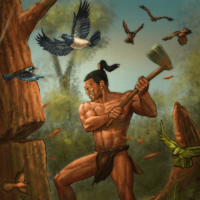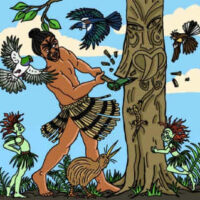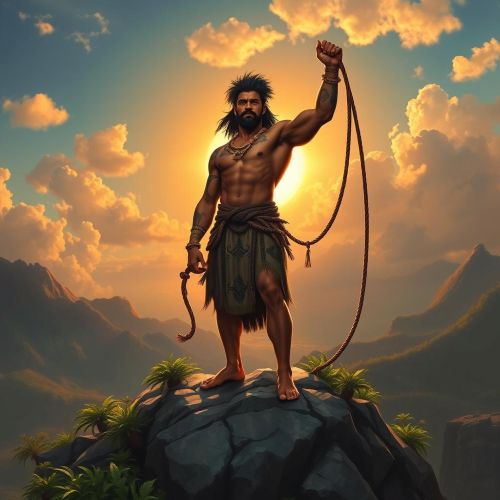Rata : The Revengeful Son
Listen
At a glance
| Description | |
|---|---|
| Origin | Tahitian Mythology |
| Classification | Mortals |
| Family Members | Vahieroa (Father) |
| Region | Tahiti |
| Associated With | Bravery, Warfare |
Rata
Introduction
Rata, a prominent figure in Tahitian mythology, embodies the archetypal hero: driven by vengeance, resourceful, and ultimately victorious. His story, passed down through generations, carries themes of filial duty, the power of nature, and the perilous nature of the sea. Rata’s ascension to kingship came after the tragic loss of his father, Vahieroa, and uncle, King Tumu-nui, who were swallowed by a great clam during a voyage to Pitcairn. As he matured, Rata resolved to avenge his father’s fate.
Physical Traits
Rata is depicted as a central protagonist in Tahitian myths and legends, embodying the epitome of heroism and valor. Descriptions of his physical appearance are scarce within traditional narratives, yet his actions and cultural context suggest certain characteristics. As a prince and later king, Rata likely possessed a stature and bearing befitting royalty, alongside the strength and stamina required for his quest to avenge his father. While specific physical traits are not explicitly mentioned, Rata is consistently portrayed as a brave and determined warrior, embodying Polynesian values of bravery, perseverance, and respect for tradition.
Family
Rata’s lineage within Tahitian mythology is steeped in both tragedy and heroism. His father, Vahieroa, held either the title of king or a high-ranking chief, depending on the version of the myth. In certain accounts, Vahieroa meets a treacherous end, igniting Rata’s quest for vengeance. Rata’s mother is named variably across sources; some refer to her as Matamata-taua, indicating her esteemed status, while others simply identify her as a chiefess. Rata’s family includes notable figures like his uncle, Tumu-nui, depicted as a powerful leader who accompanied Vahieroa on their ill-fated voyage.
The demise of Vahieroa and Tumu-nui, swallowed by a great clam during their journey, became the catalyst for Rata’s pursuit of revenge. This tragic event underscores the pivotal role of Rata’s family in shaping his destiny and motivating his heroic endeavors within Tahitian mythology.
Other names
Rata is known by different names across various Polynesian cultures, reflecting unique interpretations and local traditions. In Tuamotu mythology, he is referred to as Rata, while in Māori mythology, he is known as Rātā. In Hawaiian and other Polynesian traditions, he is sometimes called Laka. Additionally, in some legends, he is known as Lata, emphasizing linguistic nuances and regional variations. These alternative names highlight the fluidity and adaptability of mythological narratives, illustrating how Rata’s story transcends geographic boundaries while preserving its core themes and symbolism.
The name “Rata” holds significance in the Tahitian language, where it means “tame” or “gentle.” This seemingly contradictory name might symbolize the duality within Rata—a fierce warrior seeking vengeance yet also a future king responsible for his people’s well-being. Interestingly, certain versions of the myth refer to him as “Vahi-e-roa” or “Far-off-place,” possibly hinting at his destined journey or his sense of isolation as an orphaned prince. These various names and interpretations add depth to Rata’s character, enriching his mythological legacy across the Polynesian cultural landscape.
Powers and Abilities
Rata’s strength encompasses more than just physical prowess; it extends to his resourcefulness and profound connection with the natural world. In certain versions of the myth, he demonstrates exceptional skill in navigating treacherous seas, crucial for his quest of revenge. Rata is also portrayed as cunning, adept at outsmarting or manipulating supernatural entities to achieve his objectives. Some narratives highlight his affinity with forest spirits or “atua” dwelling in sacred groves, engaging in bargaining or possessing ritual knowledge to harness their powers.
His ability to interact with the spirit world underscores his destiny as a chosen champion. However, Rata’s most remarkable attribute is his unwavering determination. Despite confronting monstrous creatures and perilous situations, he remains steadfast in his pursuit of justice. This resolute resolve enables him to conquer seemingly insurmountable challenges and emerge victorious in his heroic endeavors.
Modern Day Influence
Rata’s legendary adventures continue to exert a profound influence on modern Polynesian culture. His tales are celebrated in various art forms, such as Tahitian dance and Polynesian music, which draw inspiration from the island’s rich myths and legends, including those of Rata. Through these cultural expressions, Rata’s narrative emphasizes values of courage, determination, and respect for tradition in the face of adversity.
In contemporary Tahitian society and beyond, Rata’s iconic image is incorporated into traditional tattoo designs, symbolizing attributes like strength, courage, and the enduring bond between father and son. Artists, writers, and filmmakers alike find inspiration in Rata’s legend, reinterpreting it for present-day audiences. Notably, Māori writer Witi Ihimaera’s 2003 play “Rata” offers a modern reinterpretation of the myth, exploring themes of identity, exile, and the legacy of colonialism through Rata’s journey.
Rata’s tale also resonates across other Polynesian cultures, with variations of the story existing in Maori and Tuamotuan mythology. Furthermore, the universal themes embedded within Rata’s narrative—such as vengeance, filial duty, and triumph over monstrous adversaries—draw parallels with hero narratives from diverse cultures worldwide, ranging from Greek myths to the epic tale of Beowulf. This universality solidifies Rata’s enduring place among the pantheon of mythological heroes celebrated throughout human storytelling traditions.
Related Images
Frequently Asked Questions
What is lorem Ipsum?
I am text block. Click edit button to change this text. Lorem ipsum dolor sit amet, consectetur adipiscing elit. Ut elit tellus, luctus nec ullamcorper mattis, pulvinar dapibus leo.
What is lorem Ipsum?
I am text block. Click edit button to change this text. Lorem ipsum dolor sit amet, consectetur adipiscing elit. Ut elit tellus, luctus nec ullamcorper mattis, pulvinar dapibus leo.
What is lorem Ipsum?
I am text block. Click edit button to change this text. Lorem ipsum dolor sit amet, consectetur adipiscing elit. Ut elit tellus, luctus nec ullamcorper mattis, pulvinar dapibus leo.
What is lorem Ipsum?
I am text block. Click edit button to change this text. Lorem ipsum dolor sit amet, consectetur adipiscing elit. Ut elit tellus, luctus nec ullamcorper mattis, pulvinar dapibus leo.
What is lorem Ipsum?
I am text block. Click edit button to change this text. Lorem ipsum dolor sit amet, consectetur adipiscing elit. Ut elit tellus, luctus nec ullamcorper mattis, pulvinar dapibus leo.






